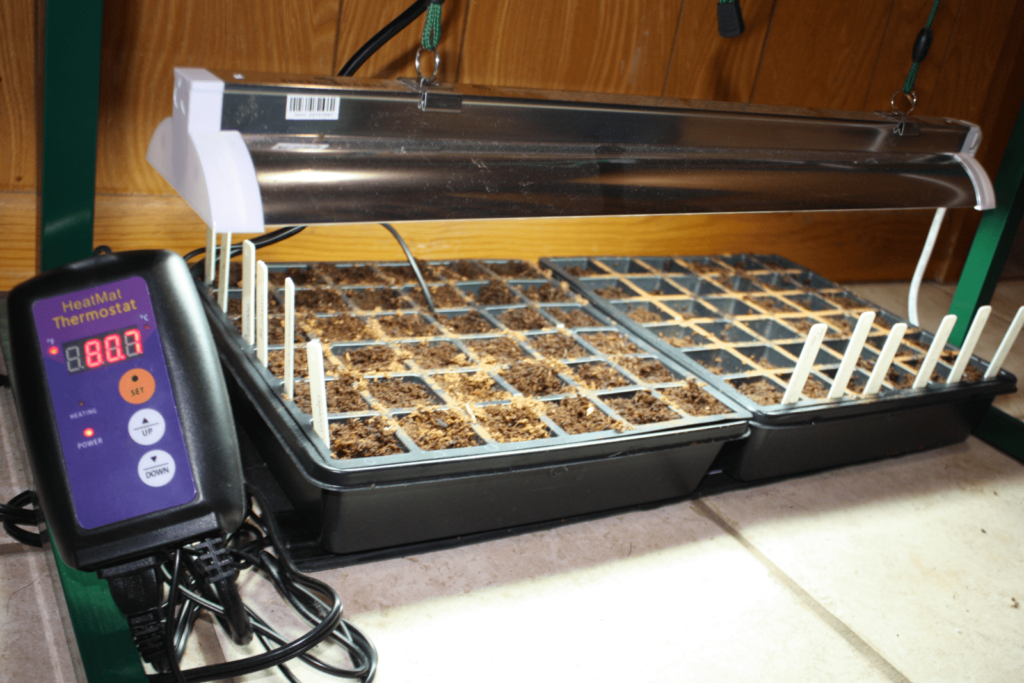I have been starting seeds using a heat mat and this past weekend I started my pepper seeds indoors so they’re ready to transplant outside when our temperatures warm and the threat of a freeze has passed. Many people ask…
Do I really need a heat mat for my seeds to germinate?
The short answer is Yes!
Seeds germinate when the soil temperature is warm and germinate quickly when the soil temperature remains constant.

Using a Heat Mat to Germinate Summer Vegetables
Are you starting seeds indoor this winter for your summer garden? If you start seeds indoors in the winter, floors are cold, windows are sometimes drafty and the temperature is never constant. The air temperature in my home ranges from 65 – 68 degrees in the winter, which is not warm enough for seed germination. Seeds need varying degrees for germination ranging anywhere from 60 degrees – 95 degrees. If I’m starting a variety of seeds in the same seed starting tray, I’ll set the thermostat on my heat mat to around 85 degrees.
- Corn 70 – 95 degrees
- Cucumber 70 – 95 degrees
- Parsley 65 – 85 degrees
- Peppers 70 – 90 degrees
- Summer Squash 70 – 95 degrees
- Tomatoes 70 – 90 degrees
- Watermelon 75 – 95 degrees
- Winter Squash 70 – 95 degrees
Use a Heat Mat to Germinate Cool Season Vegetables
In the summer time, I use my heat mat to start my cool season vegetable seeds because the soil out in the garden is too hot and the sun is too harsh on the heat sensitive winter seedlings. In the summer, I start my brassicas indoors and set my heat mat between 72 – 74 degrees. The followings seeds are the ones I germinate indoors during the summer for fall transplanting:
- Broccoli 45 – 85 degrees
- Cabbage 45 – 95 degrees
- Cauliflower 45 – 85 degrees
- Celery 70 – 75 degrees
- Kale 50 – 65 degrees
- Mustard Greens 45 – 85 degrees
- Rutabaga 45 – 85 degrees
I highly recommend starting seeds using a heat mat with a controllable thermostat. This will ensure your soil is heated to the optimal temperature and the heat remains constant. I use both the Apollo Heat Mat (discontinued) and the VivioSun Heat Mat
Seeds like lettuce, turnips, radish, and peas germinate at the the 65 degree range and up, so typically I sow those directly in the garden as we have mild winters. As a result, this frees up seed starting trays for the seeds that require more heat to germinate.
After your seeds have germinated, the heat mat must be removed from your seedling tray. Seedlings prefer the natural cooling that occurs at night which will help to prepare and strengthen those seedlings for the real world conditions outside.
Be sure to place your seedlings under a grow light so they grow strong and are not leggy. Previously, I have placed seedlings in my window sill, but they end up leggy and weak. I highly recommend using a grow light that is height adjustable; place the light approximately 2″ from the top of your seedlings. I use the Jump Start Grow Light and it has worked perfectly for years.


